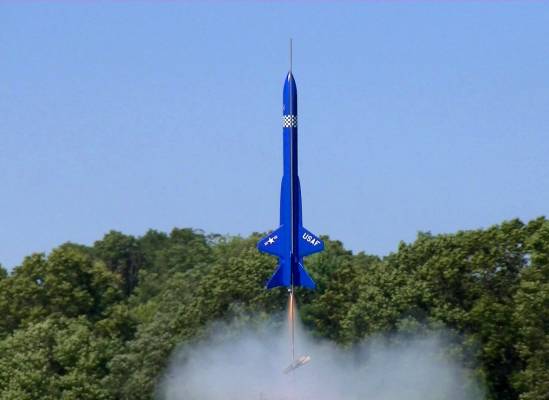The X-15: This is a "Sport-Scale" (not true scale) model of the famous X-15 rocket-powered research plane. This particular kit appears to be newer than other Quest X-15 kits described here: It is a few inches longer, and a recommendation by Quest to only use the A8-3 or A6 motors. (Mine is definitely too heavy to fly on an A8). I chose to paint my particular model gloss blue (not the historically accurate black).
My kit came out pretty heavy as I used a full-sized can of Rustoleum 2X paint trying to get a smooth, glossy finish. Apparently light coats of this paint leave the finish in something like an orange-peel texture, cool but not good for low drag. I discovered heavy, thick coats that would run with normal paints made for a smoother, glossy finish. But by then, there was so much primer and paint on this model that it almost doubled the weight of this kit. In MHO, Rustoleum 2X (from Home Depot) sucks for flying models. I wish I would have used the ridiculously expensive yet lighter Testors stuff at $5 for a tiny 3-oz. can.
The X-15 finally got a payload section addition. This adds another 3 inches to the rockets overall length. This will hold the Altimeter Two, which no longer is at risk of ejection shock damage or loss if the clip fails. The added bulkhead, painted payload tube and padding only adds an additional 13.6 grams of weight to this model.
She flies well and is not affected by the wind much, though I wish I could get her to venture a little closer to the clouds. Actual measurements with an altimeter on board shows this model can go much higher than I estimated, with a C6-3 it reached 437 feet, and traveled at 89 mph. That's enough to have it fly higher than the Great Pyramid of Giza, now that it has eroded about 25 feet.
| Flight Date: | 2012-08-11 |
| Rocket Name: | X-15 |
| Kit Name: | Quest - X-15 {Kit} (2014) |
| Flyer's Name: | Rich DeAngelis |
| Motors: | C6-5 |
| Expected Altitude: | 336 Feet |
| Wind Speed: | 8.00 mph |
| Launch Site: | Halifax, PA |
| Actual Altitude: | 251 Feet |
While the Quest X-15 always flew well in winds, with the newly added three inches of payload section, how this would fly was only a guess. As it turned out, performance numbers were off by a significant amount, but not terribly so, as the flight was a perfect flight and a good way to end the day.
The C6-5 burned for a nominal 2.1 seconds, and the peak acceleration was 6.1 Gs, about one half a G lower than without the payload section. The average acceleration was 1.6 Gs. That was enough acceleration power to get the X-15 flying to 73 mph, more than 10 mph slower than usual. It coasted for 2.7 seconds and then reached an apogee of 251 feet, or about 50 to 100 feet lower than average for a C6 motor. After apogee it lost 27 feet in the last 1.4 seconds before ejection. This particular motor had a short delay time of only 4.1 seconds, and at 224 feet the parachute deployed and the X-15 descended at 9 mph to a soft grass landing 22 seconds after liftoff. This rocket tends to have a wide range of altitudes and speeds, so a few more comparison flights will show a truer picture of the performance cost of having a payload section.
| Stage | Motor(s) |
|---|---|
| 1 | Quest C6-5 |
 |
 |
